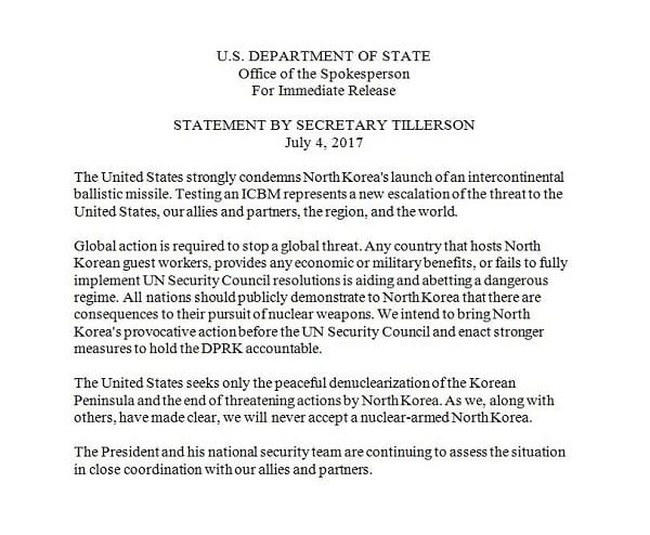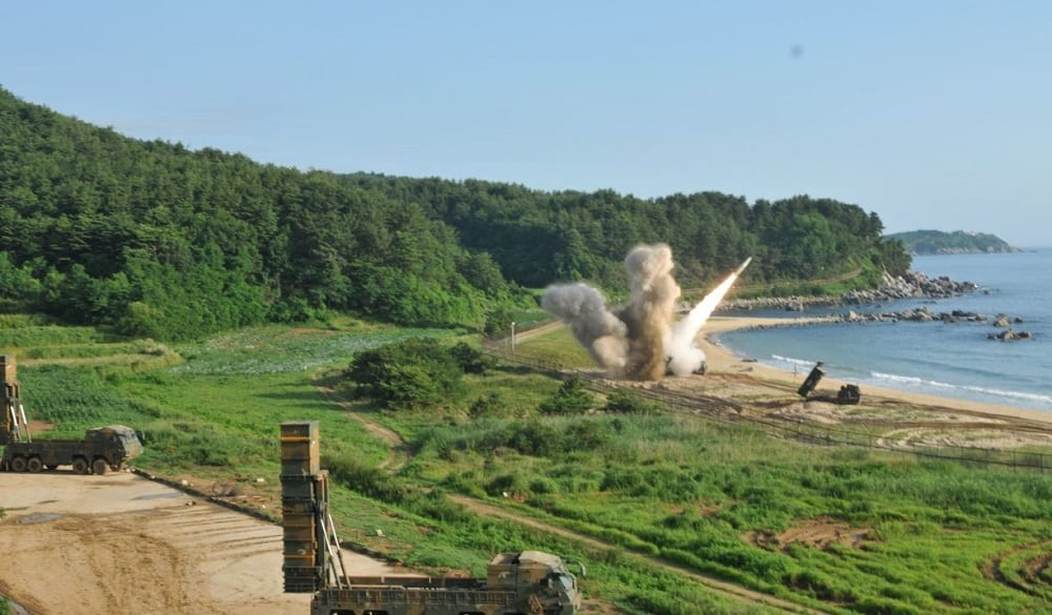On July 4, North Korea time, the Kim Jong Un regime conducted a test of what was technically an ICBM. For the first time, a part of the United States, Alaska, was brought within the range of North Korea’s nuclear arsenal. The background is in the story I posted earlier today.
Several things have happened in the meantime.
The US and the ROK conducted a joint live fire exercise of short/intermediate range, but highly capable, missiles. This was directed from the highest levels in South Korea so we may assume the same applies to the United States
https://twitter.com/AskAKorean/status/882390685487321088
The U.S. Army and South Korean military responded to North Korea’s latest launch with their own exercise of missiles, launching them Wednesday into South Korean territorial waters along the country’s eastern coastline, U.S. Pacific Command said in a statement. The launches were directly in response to “North Korea’s destabilizing and unlawful actions,” Pacific Command said.
The Army used its Army Tactical Missile System and South Korea used its Hyunmoo Missile II, which can be deployed rapidly and provide “deep strike precision capability,” Pacific Command said.
The ATACMS has a range of about 190 miles (range is limited by the Intermediate Range Nuclear Forces Treaty with Russia) but it has an accuracy of about 10 meters. The Korean developed Hyunmoo II has a range of nearly 500 miles and can strike anywhere in North Korea.
Since the launch, the South Koreans have provided more details and they are not happy.
South Korea’s defense ministry on Wednesday confirmed North Korea’s test of a new intercontinental ballistic missile (ICBM), identifying it as an upgraded two-stage version of its KN-17 or Hwasong-12 missile.
During a parliamentary briefing, Defense Minister Han Min-koo said that the ministry put the missile’s range at between 7,000 kilometers and 8,000 km but found no definitive evidence to prove its atmospheric re-entry capability.
The minister warned that Pyongyang’s reckless provocation will lead to its “self-destruction,” calling it a clear violation of U.N. resolutions proscribing any test of ballistic missile technology.
“If the North Korean regime presses ahead with reckless provocations, it would face stern sanctions from the international community and, in the end, its self-destruction,” Han told a session of the National Assembly’s defense committee.
Defense Minister Han Min-koo speaks during a parliamentary session at the National Assembly in Seoul on July 5, 2017. (Yonhap) Defense Minister Han Min-koo speaks during a parliamentary session at the National Assembly in Seoul on July 5, 2017. (Yonhap)
“We are keeping close tabs on the North’s movement in close cooperation with the U.S. (forces) and preparing — based on the South Korea-U.S. alliance — to respond sternly to any provocation,” he added.
Kim Jong Un engaged in smack talk
We have to take Kim at his word as his comments are aimed at a domestic audience and at party loyalists. He says he won’t negotiate nukes or missiles, and nukes and missiles are the only things we want to talk about. It is hard to see how he will be able to climb down from this position.
The most significant item though was Rex Tillerson’s statement. In my post earlier I had speculated that the United States would continue to call the missile an IRBM because earlier in the year Nikki Haley had intimated that a successful launch of an ICBM could constitute casus belli.

This is huge. Tillerson’s last statement on a missile launch was just a few words:
“North Korea launched yet another intermediate range ballistic missile. The United States has spoken enough about North Korea. We have no further comment”.
This contradicts the USPACOM statement from earlier and calls this missile what it is, an ICBM.
The launch of this missile is a geopolitical challenge for the Trump administration.
The development presents President Donald Trump with his biggest foreign-policy challenge and raises the potential costs of military action against Pyongyang. It comes as Mr. Trump has expressed frustration with China’s inability to curb North Korea’s advancing weapons program.
U.S. Ambassador to the United Nations Nikki Haley on Tuesday requested an urgent U.N. Security Council meeting on North Korea, spokesman Jonathan Wachtel said. A U.N. spokesman said the session would be held at 3 p.m. Wednesday. The U.S. requested that the meeting be open.
The missile test is likely to push North Korea up the agenda Friday and Saturday at a meeting of leaders of the Group of 20 advanced nations in Germany, where Mr. Trump is set to hold a separate meeting with the leaders of Japan and South Korea.
The Trump administration has sought to increase pressure on China, North Korea’s top trading partner and ally, to take greater action to cut off Pyongyang’s economic lifeline. Mr. Trump is set to meet Chinese President Xi Jinping at the G-20 summit in Hamburg.
Something has to be done and the ball is squarely in the administration’s court.














Join the conversation as a VIP Member